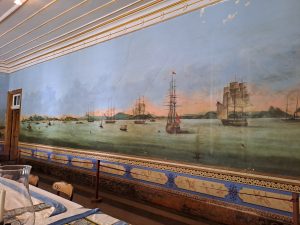Who was Villaronga?
Jose Maria de Villaronga y Panella was a versatile Catalan artist, born in Barcelona in 1819. He immigrated to Brazil between 1842 and 1846, seeking opportunities in the flourishing field of decorative mural painting. His career extended beyond Rio de Janeiro, reaching significant urban centers in the “Serra Acima” region, encompassing the Paulista and Fluminense Vale do Paraíba, also known as the Vale do Café (RJ) and Vale Histórico (SP).
How did he arrive in the Vale do Paraíba?
Upon arriving in Brazil, Villaronga chose to operate in the central-southern coffee region, particularly in cities like Vassouras, Valença, Paraíba do Sul, and Bananal. This strategic choice reflected his perception of the expanding artistic field in the region, the economic nucleus of the Empire. The slave-owning ruling class sought to express its political, social, and economic power through refined decorations, providing Villaronga with fertile ground for professional development. Possibly, the Catalan artist left his hometown, Barcelona, due to various conflicts and civil wars.
Where are his works located?
The works of José Maria de Villaronga y Panella are primarily concentrated in the residences of the Vale do Paraíba in São Paulo and Rio de Janeiro. His creations can be found in luxurious farmhouses symbolizing the opulence of rural aristocracy during the peak of coffee production, as well as in churches, chapels, and cultural spaces in different cities. The Instituto Aupaba, in partnership with the Brazilian Ministry of Culture and with the support of the Government of Catalonia, is developing the itinerary on the life and work of Villaronga throughout 2024.
If you are interested in discovering more about this important Brazilian region, we suggest visiting the website of the Vale do Café Convention & Visitors Bureau, our local institutional supporter.
What is Villaronga’s relevance for Brazil and Catalonia?
José Maria de Villaronga y Panella’s work plays a crucial role for both Brazil and Catalonia.
In the Brazilian context, his contributions to cultural history are invaluable, transforming the artistic landscape of the Vale do Paraíba during the 19th century. Capturing visually the opulence of rural aristocracy during the coffee boom, his pictorial decorations in residences provide visual testimonies preserving Brazilian history, not only aesthetically but also documenting architectural aspects and social practices of the time. Additionally, his active participation in slave-owning society, linked to large land fortunes, highlights his integration and influence in this complex historical context.
For Catalonia, Villaronga’s work stands out as a notable example of the Catalan diaspora and the promotion of culture beyond borders. By bringing his artistic and stylistic skills to Brazil, he contributed to the internationalization of Catalan talents, enriching Brazilian cultural diversity. Thus, Villaronga not only left a valuable legacy in Brazilian history and art but also served as a cultural ambassador, promoting Catalan identity internationally in his time. Nowadays, recovering his life and work is a mission of the painter-decorator and researcher Ana Claudia de Paula Torem.
Who is the main source on Villaronga’s life and work?
The main source on the life and work of José Maria de Villaronga y Panella is the painter-decorator and historian Ana Claudia de Paula Torem, a Ph.D. History at UniRio. Her research work provides valuable insights into the legacy of this remarkable Catalan, highlighting his artistic contribution to the Vale do Paraíba region. Learn more here.
Can you support the “Caminhos de Villaronga” project?
Yes, you can financially support our project, helping thousands of individuals who depend on tourism in the Vale do Paraíba Fluminense and Paulista. Learn how.
The Instituto Aupaba is a non-governmental, non-profit organization specialized in impactful actions and projects focused on territorial development, with a focus on regenerative tourism. Our approach considers environmental, social, and governance (ESG) dimensions, supporting institutions and companies interested in contributing to planetary well-being.
For us, tourism is an instrument of social and economic transformation!
All photos kindly provided by Ana Claudia de Paula Torem.



